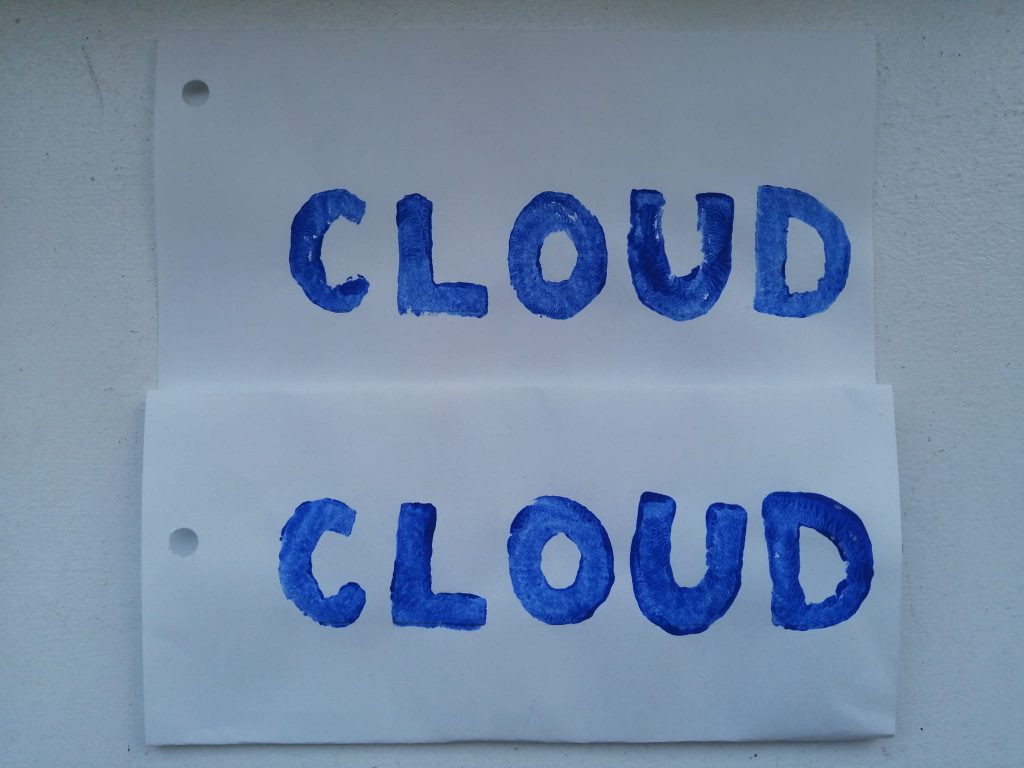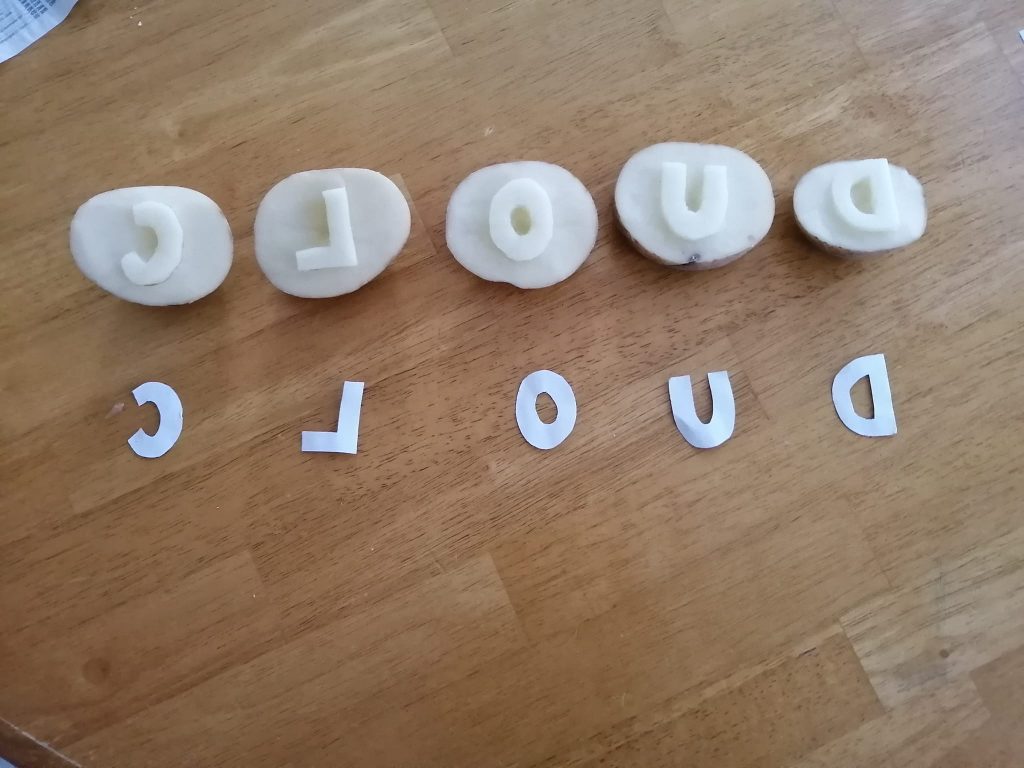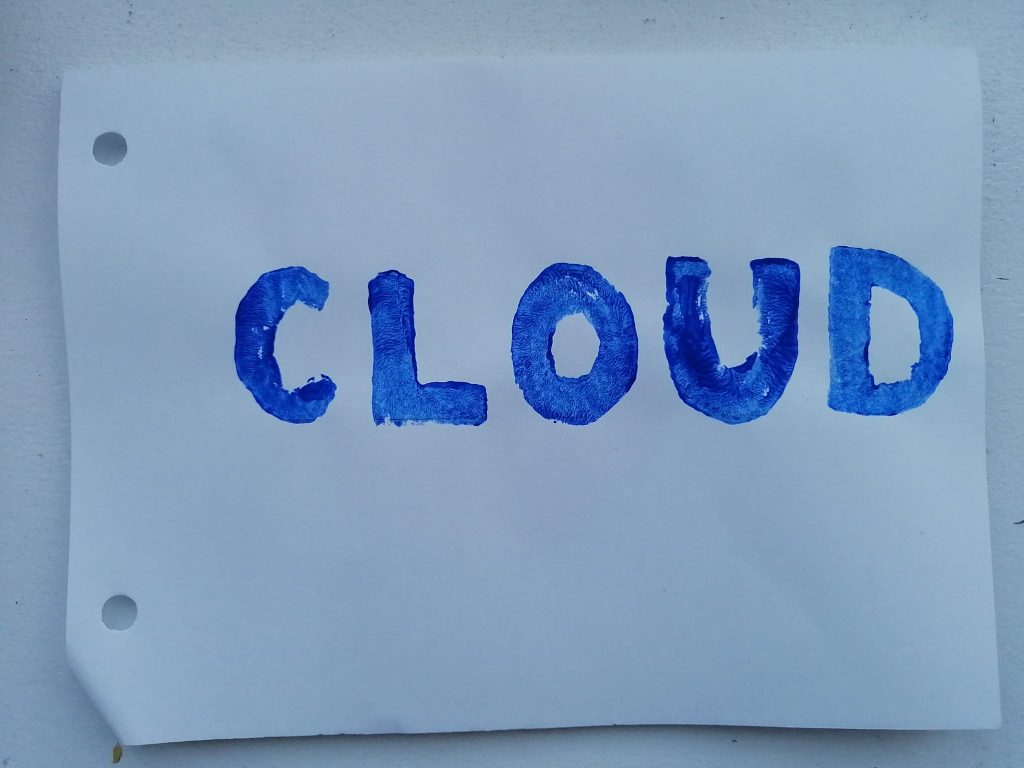
I made potato stamps to print the word, “C-L-O-U-D.” I tried my very best to get accurate and clear results with the two copies.
Process
I used two potatoes, a toothpick, and a knife to create the stamps. Before carving, I made stencils of my letters on a sheet of paper, because that would help guide the carving. I used a toothpick to poke holes around the stencils and into the potatoes, and then carved by connecting the dots (holes). The stamps themselves would look better too, as there will not be any residue pen marks.
I used blue paint to stamp the letters onto the paper, but it took many tries to get a clear result. For the second copy, I used a ruler to measure the exact distance between each letter (vertically and horizontally) in the first copy so I could adjust the position of the stamps to match. I thought of this method because I already knew from the first attempt that it is difficult to align the stamps because you cannot see exactly where you are stamping on the page (blocked by the back of the potato). The entire process took about 2.5 hours.

Challenges
Since I am not much of a handicraft person, nor am I nimble with my fingers, I had predicted some challenges with creating these potato stamps prior to starting. Since I am not good at carving, I chose words without letters that are very asymmetrical or with many curves. I also know that the letters in the stamps must be carved backwards (mirroring the page) for it to face the right direction on paper. Thus, I selected words without letters that are difficult to write backwards. I mostly avoided the letters G, R, S, F, B, S, and N, and I chose to design the letters as all capitals and in block font. Straight lines in block fonts are easier to carve than curved ones in a bubble font. Using capital letters also decreases the chances of having to carve out many round edges needed in their lowercase counterparts. Letters that are hollowed out in the middle (O, D) were a challenge to carve without breaking a part of the stamp.
Although I am not good at carving, I was surprised at the easiness in which the knife slid into the potato. It cut the flesh smoothly without much effort. However, one challenge I did not anticipate was the amount of liquid that was excreted from the potato throughout the process. For one, I did not expect the potato to burst with juices every time I struck the knife inside the flesh. Slicing a potato in half did not cause this to happen, but I suppose it might have occurred because I was handling the knife in a very small area of the potato and had to concentrate the force on carving the letter out without ruining the entire piece.

A second instance was that during the stamping, the paint continued to slide off the potato, muddling the letters. A reason for this could be because the paint was only resting on top of the potato, which would easily slip off the potato’s wet surface, and off the paper. If these stamps were actual stamps (for common use), the ink would have been easily absorbed into the rubber stamp. All that is needed is for pressure to be applied to the rubber stamp and the ink would efficiently transfer onto paper. I had to attempt the stamping many times before I could get it right. A strategy I used was coating the stamp in a very thin layer of paint and applying less pressure to reduce slip. I had to use many paper towels to soak up the potato juice as I carved and to wipe off the paint as I stamped. This process is fairly similar to tattooing, where one must continue cleaning off ink and blood that emerge as they insert the needle into the skin.
Observations
My results are satisfactory, and I could say that both copies are fairly similar.

C – This letter was not too difficult to carve as there was just one curve.
L – This letter was the easiest to carve, due to its long straight lines and edges.
O – This letter was the most enjoyable to carve, because the knife glided very smoothly as I moved the potato around in a circle. The hollowed-out middle was a bit challenging, though.
U – Like C, this letter was also not difficult to carve because there is just one curve.
D – This letter was the most difficult to carve, as there was a curve, a straight side, and I had to hollow it out in the middle.
Insights
Although the process was long and took a lot of patience and effort, this experience was nonetheless very enjoyable. I would say that patience is key to this task, which makes this process quite therapeutic. I was away from my phone and laptop for a few hours, and only focused my energy and attention on this craft. Making something by hand and seeing the results is not something I do everyday. Asides from writing with pen and paper, most of my output is computerized or digitized in some way or another. It is refreshing to see something creative that was achieved by my own hands from start to finish. The piece has an intimate, personalized touch to it.
Similar to a typewriter or a printing press, writing using potato stamps is a “one attempt only” process. If there is an error, you cannot go back and erase, or change the font style, size, or colour like you can on a computer. Once a mistake is made, you must start all over from the beginning. Therefore, you must plan ahead and anticipate any mistakes to prevent. Admittedly, I thought of a plan and strategy to carry out before starting the handiwork of this task. On a computer, writing is recurrent, and gives room for mistakes or a change of mind since amendments can be made in an instant.

In creating the second copy, I learned that no matter how much I tried, I probably could not make both copies identical due to the human hand nature of this stamping process. There is bound to be some misalignment. However, on a computer, writing device, or photocopier, exact replications can be made with a click of a button. We learned that Gutenberg aimed to make the new mediums more economical than the last, and that his inventions were a close imitation of the medium it replicated (Bolter, 2001). Potato stamps made me embrace craftmanship and the wonders of the human hand engaged in the creative process. Despite the accuracy and efficiency of computers and other technological devices that imitate handwriting and printing, the tenacity of human touch cannot simply be replaced.
For further thinking, this task makes me wonder if people are likely to be more creative when they are writing by hand or on a device. Would the limited boundaries and the “one attempt only” process by hand/stamping intimidate people and hinder their creativity? Or would handwriting/stamping give a more personalized feel to the creative process, one that is closer to the heart? Would writing on a computer be easier since there is the backspace button and endless features on the word processor that can be conveniently customized to one’s liking? Would facing piece of paper or a screen affect creativity in anyway?
Reference
Bolter, J. D. (2001). Writing space: Computers, hypertext, and the remediation of print (2nd ed.). Lawrence Erlbaum.
2 replies on “Task 4: Potato Printing”
Hi Natalie! You did a beautiful job and thought this process out so well. I too found the activity so therapeutic. It really does require patience, and I was surprised at how patient I was once I accepted that this was not a quick activity. I am with you on the question of creativity by hand vs. on a computer and think that maybe it depends on the individual. Personally, I think I am more creative and unique when working with my own hands and am forced to build from scratch. That said, there are many times where I would hit creative blocks if I did not have the digital scaffolding that presents itself in the form of online idea generators to springboard off.
WOW! You did such a great job on this assignment. I am impressed with how clear your letters came out. I did not have the same experience. I found this to be extremely frustrating and not at all therapeutic. Thank you for sharing your insights and art.